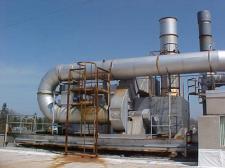Catalytic Recuperative Oxidizers: What they are, what they do & more

Catalytic Recuperative Oxidizers destroy pollutants discharged in industrial processes
Basic Catalytic Recuperative Oxidizer process: Air laden with Hazardous Air Pollutants (HAPs), Volatile Organic Compounds (VOCs) and other odorous emissions that are created through various industrial processes passes through catalytic oxidizer systems, where the air is heated and the pollutants are destroyed.
Catalytic oxidizers achieve high VOC destruction efficiency by heating and maintaining a polluted airstream at temperature (typically 600 to 650F) for a set “dwell” time as it passes through catalyst material. The lower operating temperature of a catalytic oxidizer results in much lower fuel use than thermal recuperative oxidizers. VOC destruction efficiency can reach 99+%. Catalytic oxidizers can operate with an integral heat exchanger for fuel savings, or without a heat exchanger for capital cost savings.
Catalytic systems perform well in clean applications with no halogens, sulfurs, silicone, or particulates. These systems have a long life because they operate at a much lower temperature than thermal recuperative oxidizers.
Questions to ask when considering a catalytic recuperative oxidizer (CATOX)
It depends on numerous factors. See Selecting an Oxidizer for guidance or call us for guidance.

The Three T’s of Catalytic Oxidizers – Time, Temperature and Turbulence
Note: Gas hourly space velocity (GHSV) is sometimes substituted for “time” when describing catalytic system performance. Two T’s of turbulence and temperature are critical in a catalytic oxidizer. The third “T” of time is better defined by gas hourly space velocity (GHSV) which is a technical term that defines a ratio of catalyst volume to treated airflow volume. It is a critical value in determining the performance and life expectancy of a catalytic system. High GHSV values represent lower performance and shorter catalyst life.
Who Uses Catalytic Oxidizers?
Catalytic Oxidizers are used by manufacturers in a wide range of industries and applications. The Kono Kogs team has experience with practically every possible oxidizer application across many industries around the globe.
Industrial Processes using Catalytic Oxidizers
Many industries incorporate catalytic oxidizers in their pollution control systems. Some industrial processes where they're used include:
- Fiberglass gel coating
- Industrial Bakeries
- Pharmaceutical production
- LCD panel production
- Semiconductor fabrication
- Steel furniture paint booths
- Wood furniture surface finishing
- Rotogravure printing
- Flexographic printing
- Heatset web offset printing
- Label printing
- Rubber production
- Automotive paint processes
- Medical products
- Material coating
- Surface coating
- Wood Products
- Chemical processing/manufacturing
- Lamination
- Spiral core winding
- Foil stamping
- Flow coating
We have an in-depth understanding of every process airstream our systems are used to treat. Explore our case studies or contact us with questions about the different technologies available for your specific application.

How Much does a Catalytic Oxidizer Cost?
The cost of a catalytic oxidizer addition includes the initial capital investment in the equipment as well as the operating and installation costs. Buying a pre-owned, fully refurbished catalytic oxidizer from Kono Kogs can save you 40% or more in capital costs compared to the cost of new, with comparable guarantees and warranties.
Kono Kogs recommends carefully thinking through the Total Cost of Ownership (TCO) before making a purchase. A catalytic oxidizer system with a low capital cost might not represent your lowest TCO in operation over time. As a rule of thumb, consider a two-year period when calculating the total cost.
Capital Costs Include:
- Equipment
- Shipping
- Installation
- Commissioning (start-up)
Operating Costs Include:
- Fuel
- Electricity
- Compressed air
- Maintenance service
Both capital and operating costs can vary widely between different catalytic oxidizers. Some TOX technologies have fuel costs 5-10x higher than other systems. A Catalytic Oxidizer with a low initial cost could have a higher TCO over two years compared to that of a Catalytic Oxidizer or Regenerative Thermal Oxidizer.
Kono Kogs is happy to provide a cost-benefit analysis for your project. We’ll compare multiple technologies, explain the trade-offs of each option, and give you our professional recommendation on the most cost-effective system.
Questions to ask when considering a catalytic recuperative Oxidizer (CATOX)
- Is a catalytic oxidizer the most cost-effective oxidizer solution for my airstream?
- See Selecting an Oxidizer for guidance or call us for guidance
- Are catalyst poisons (halogens) in the airstream?
- If present, consider a different oxidizer technology
- Are catalyst masking agents/contaminants (silicone, phosphorus) in the airstream?
- If present, low concentrations may still be viable for catalytic technology
- If present in high concentrations, consider a different oxidizer technology
- A heat exchanger is a cost-effective option for most applications
- For catalytic systems, plate or shell & tube heat exchangers will perform well
- Is there a potential for particulates?
- Catalytic systems do not handle particulates well; consider other technologies
- VOC concentrations over 16% will require special consideration

Kono Kogs Knows Everything about Catalytic Oxidizers
Kono Kogs is the world’s leading supplier of used oxidizers. We also offer oxidizer field services including turnkey installation, repair, preventive maintenance, and upgrades. Our team has over 150 years of combined experience, and a 100% success rate in meeting performance guarantees. Whether we can help you get more years out of your existing system or find a replacement, we look forward to the challenge!
Kono Kogs is the world’s leading supplier of used catalytic recuperative oxidizers.
Reach out to us for a quote or contact Kono Kogs for more information.
MEGTEC Catalytic Oxidizer Treating Metal Decorating Emissions
A 3 piece can maker replaced an aging catalytic oxidizer with a higher capacity catalytic recuperative oxidizer (catox) for their wicket oven. The solution provided had exceptionally low capital cost compared to new equipment, allowed increased process line speed, and now (in 2024) has provided over 20 years of reliable performance.


